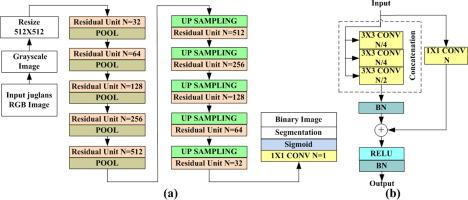当前位置:
X-MOL 学术
›
Comput. Electron. Agric.
›
论文详情
Our official English website, www.x-mol.net, welcomes your
feedback! (Note: you will need to create a separate account there.)
Impurity detection of juglans using deep learning and machine vision
Computers and Electronics in Agriculture ( IF 7.7 ) Pub Date : 2020-11-01 , DOI: 10.1016/j.compag.2020.105764 Dian Rong , Haiyan Wang , Lijuan Xie , Yibin Ying , Yinsheng Zhang
Computers and Electronics in Agriculture ( IF 7.7 ) Pub Date : 2020-11-01 , DOI: 10.1016/j.compag.2020.105764 Dian Rong , Haiyan Wang , Lijuan Xie , Yibin Ying , Yinsheng Zhang

|
Abstract Impurity detection is crucial for quantitative image analysis in numerous food safety control and quality inspection applications. Rapid impurity detection of juglans using machine vision still faces challenge due to the complex shapes and color of foreign objects in different postures. Some traditional detection methods require expertly designed constraints and manual model parameters, and they have the poor detection performance and high model maintenance costs. In recent years, deep learning has become a focus in different research fields, because methods based on deep learning are able to directly learn features from training data. In this study, we originally proposed the two-stage convolutional networks to finish the image segmentation and detection of impurities in juglans images in real-time. The proposed segmentation method based on multiscale residual fully convolutional networks and classification method based on convolutional networks automatically can segment images and detect different-sized impurities (e.g., leaf debris, paper scraps, plastic scraps and metal parts) at the same time. The proposed deep-learning method is simpler and more effective, because it avoids extracting features manually, and it not only overcomes the conglomeration phenomenon between juglans and foreign objects in inline images, but also adapts to the disturb from surface abrasion damage on the white transmission belt to avoid error detection in the real factory environment. The proposed method is able to correctly segment 99.4% of the object regions in the test images and to correctly classify 96.5% of the foreign objects in the validation images and correctly detect 100.0% of test images. The segmentation and detection processing time of each image was less than 60 ms. Future work will focus on deep learning using multi-wave imaging and the sorting mechanical control.
中文翻译:

基于深度学习和机器视觉的胡桃杂质检测
摘要 在众多食品安全控制和质量检测应用中,杂质检测对于定量图像分析至关重要。由于异物在不同姿势下的形状和颜色复杂,使用机器视觉快速杂质检测仍然面临挑战。一些传统的检测方法需要专门设计约束和手动模型参数,检测性能差,模型维护成本高。近年来,深度学习成为不同研究领域的焦点,因为基于深度学习的方法能够直接从训练数据中学习特征。在这项研究中,我们最初提出了两阶段卷积网络来实时完成胡桃图像中的图像分割和杂质检测。所提出的基于多尺度残差全卷积网络的分割方法和基于卷积网络的分类方法可以自动分割图像并同时检测不同大小的杂质(例如,树叶碎片、纸屑、塑料碎片和金属零件)。所提出的深度学习方法更简单有效,因为它避免了手动提取特征,不仅克服了在线图像中胡桃与异物的聚集现象,而且适应了白色传输上的表面磨损损伤的干扰避免在真实工厂环境中检测错误。所提出的方法能够正确分割测试图像中 99.4% 的对象区域并正确分类 96。验证图像中 5% 的异物和正确检测到 100.0% 的测试图像。每幅图像的分割和检测处理时间小于60 ms。未来的工作将集中在使用多波成像和分拣机械控制的深度学习上。
更新日期:2020-11-01
中文翻译:

基于深度学习和机器视觉的胡桃杂质检测
摘要 在众多食品安全控制和质量检测应用中,杂质检测对于定量图像分析至关重要。由于异物在不同姿势下的形状和颜色复杂,使用机器视觉快速杂质检测仍然面临挑战。一些传统的检测方法需要专门设计约束和手动模型参数,检测性能差,模型维护成本高。近年来,深度学习成为不同研究领域的焦点,因为基于深度学习的方法能够直接从训练数据中学习特征。在这项研究中,我们最初提出了两阶段卷积网络来实时完成胡桃图像中的图像分割和杂质检测。所提出的基于多尺度残差全卷积网络的分割方法和基于卷积网络的分类方法可以自动分割图像并同时检测不同大小的杂质(例如,树叶碎片、纸屑、塑料碎片和金属零件)。所提出的深度学习方法更简单有效,因为它避免了手动提取特征,不仅克服了在线图像中胡桃与异物的聚集现象,而且适应了白色传输上的表面磨损损伤的干扰避免在真实工厂环境中检测错误。所提出的方法能够正确分割测试图像中 99.4% 的对象区域并正确分类 96。验证图像中 5% 的异物和正确检测到 100.0% 的测试图像。每幅图像的分割和检测处理时间小于60 ms。未来的工作将集中在使用多波成像和分拣机械控制的深度学习上。











































 京公网安备 11010802027423号
京公网安备 11010802027423号